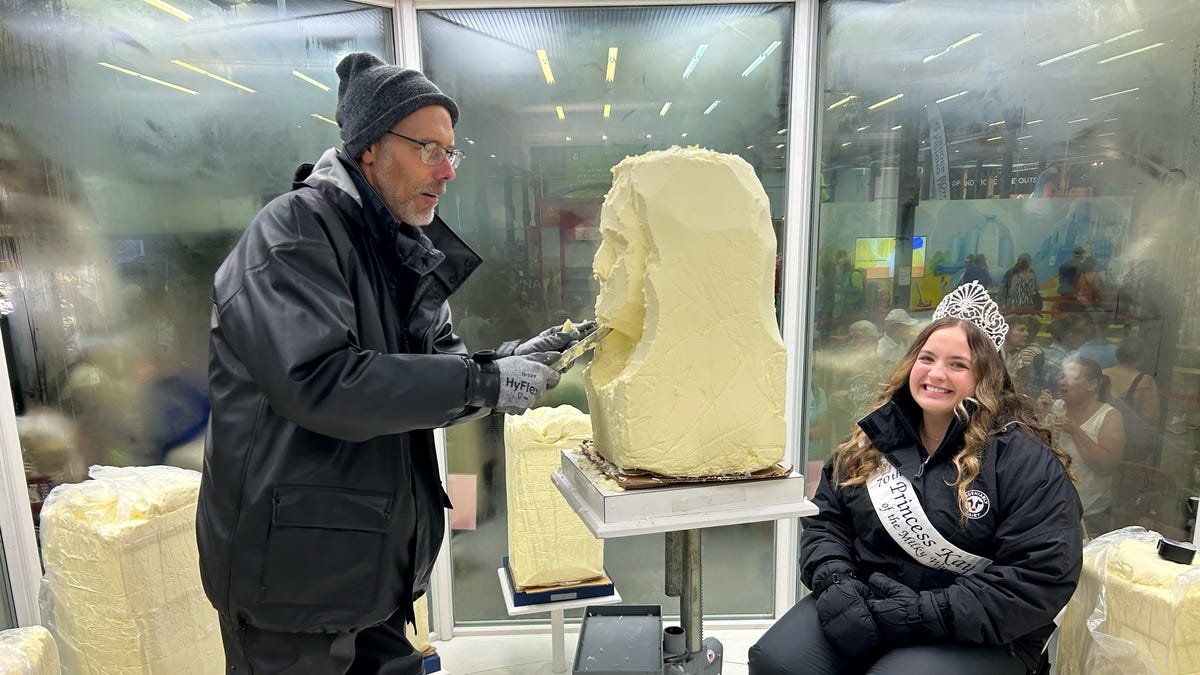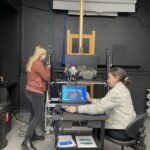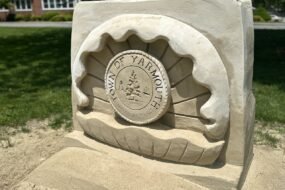
After growing up on a farm, the Minnesota State Fair’s relatively new butter sculptor says he had never dreamt of sculpting butter, but he is thrilled to be putting his hands in it.
Gerry Kulzer, whose uncle had a dairy farm in rural Minnesota, trained as a sculptor, working with clay and wood, eventually becoming an art teacher in Litchfield and working on his own sculptures. But one day, a little more than a decade ago, he watched his predecessor Linda Christensen sculpt the head of Princess Kay and the eight princess finalists out of butter. He was enamored.
A few years ago, Midwest Dairy contacted him to be the next sculptor after Christensen’s retirement. Kulzer knew it would be a learning curve, but he was up for the job. The first year, he trained with Christensen, and a couple of years ago he was on his own.
“Linda was such a great mentor and just so kind and generous,” he said. “She would do one side of the face (of the princess), and then I would do another on this big block. It was such a fantastic opportunity.”
Kulzer takes a 90-pound block of food-quality butter and carves it up into the head of one of the nine princesses each year. The princess sits in the refrigerated unit for around seven hours, posing for her bust.
Both Kulzer and the princesses are bundled in layers of sweaters and coats. Kulzer has several layers of gloves on and he tops his winter coat off with a raincoat, from which the butter just falls off. The sculptor works while the princess poses in the 40-degree refrigerated unit as Minnesota State Fair onlookers walk by.
“The butter is a harder, more firm medium. It’s kind of akin to wood sculpting. It has a grain to it,” Kulzer said. “With clay, it’s sticky; I can just slap clay together and put more on it. This is more of a subtractive process. If I make a mistake, I can kind of fix it by adding some butter, but it’s difficult.”
The sculpting at the Minnesota State Fair is different from other state fairs. In Iowa and Kansas, the scene changes each year — sometimes from “The Wizard of Oz” to a dairy cow, with the sculptor reusing the butter year after year. The butter that Kulzer uses is different — it’s fresh.
All the butter Kulzer takes off the block while he’s carving goes into a 5-gallon pail, and the princesses get to take the bucket home and use it. Then, after the fair ends, each princess is given her own sculpture. The only parts of the butter that don’t get used are shavings that accidentally fall onto the floor.
Local dairy princesses: Stearns County girls named finalists for Princess Kay of the Milky Way
“If you take a stick of butter out of your refrigerator and carve into it, you can feel the firmness of it, and you can see the flakiness too as you carve away,” Kulzer said. “At the Iowa State Fair, they’re using a little softer butter. They’re putting it on top of the armature and then sculpting in the details.”
Because the butter is not contaminated, many of the contestants use the butter for feed or parties, or they donate it.
“All my tools are exclusively for butter,” he said. “I use new gloves for every butter sculpture.”
The butter sculpting booth is located in the Dairy Building at Judson Avenue and Underwood Street. It is a Midwest Dairy Minnesota State Fair exhibit and is sponsored by Minnesota’s nearly 1,800 dairy farmers. The grade AA butter is produced for this event by Associated Milk Producers in New Ulm. It takes approximately 2 1/2 gallons, or about 21 pounds, of whole milk to make a pound of butter.
A variety of butter sculptures were featured at the Minnesota State Fair from 1898 through 1927. In 1965, the American Dairy Association of Minnesota began its tradition of having the likenesses of dairy princesses sculpted in butter and constructed the original booth. The booth was updated by Midwest Dairy in 2008.
Growing up, Kulzer’s mother would churn fresh butter for his family. Having store-bought butter was a treat, he said. The sculptor also considers working on these sculptures as a gift.
“It’s so fulfilling because of the sheer fun and joy of making something for someone, and the princesses and the finalists are always so appreciative and so happy,” Kulzer said. “It’s just such an honor to be in the forefront of the dairy community. It’s because of the farmers that produce the milk and the cheese and the butter. I’m amazed that I can do this for them.”
What’s new at the fair?: Minnesota State Fair has 63 new alcoholic drinks. These are some of the specialties











